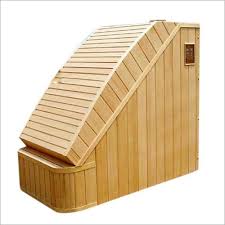A sauna is the perfect place to relax and unwind after a long day. It is a traditional Finnish way of taking a bath that is known for its health benefits. The heat of the sauna is believed to be therapeutic and can help reduce stress, help with muscle pain, and enhance the immune system. One of the most important elements of a sauna is its materials. The materials used in building a sauna can affect its performance and overall benefits. In this article, we will discuss the top traditional sauna materials and their benefits.
Cedar
Cedar is perhaps the most popular choice for a sauna. It is known for its durability and resistance to decay. Cedar is also aromatic, which adds to the therapeutic benefits of the sauna. The wood has natural oils that repel water and insects, making it an ideal material for a sauna. When cedar heats up, it releases a pleasant aroma that creates a calming atmosphere. Cedar is also easy to work with and can be finished with natural oils or left unfinished.
Hemlock
Hemlock is another popular choice for a sauna. It is a softwood with a light color that blends with any décor. Hemlock is sturdy and resistant to decay, making it an excellent material for a sauna. It also has a mild fragrance, which is similar to cedar, that adds to the therapeutic benefits of the sauna. Hemlock is easy to work with and can be finished with natural oils or left unfinished.
Pine
Pine is a softwood that is widely used in saunas. It is a less expensive option but still has many benefits. Pine has natural resins that repel water and insects. It is also easy to work with and can be finished with natural oils or left unfinished. Pine has a mild fragrance that is refreshing to inhale while in the sauna.
Spruce
Spruce is a popular material for saunas in Europe. It is a softwood that is light in color with a pleasant aroma. Spruce is easy to work with and can be finished with natural oils or left unfinished. It is also durable and resistant to decay, which makes it an excellent material for a sauna. Spruce has a soothing aroma that helps create a peaceful atmosphere in the sauna.
Finnish Pine
Finnish Pine is a high-quality softwood that is native to Finland. It is a popular material for saunas in Finland due to its durability and resistance to decay. Finnish Pine is also known for its pleasing aroma, which adds to the therapeutic benefits of the sauna. It is easy to work with and can be finished with natural oils or left unfinished.
Conclusion:
A sauna is a great way to relax and unwind after a long day. The materials used in building a sauna can affect its benefits. Cedar, hemlock, pine, spruce, and Finnish pine are some of the best traditional sauna materials that offer various benefits. Cedar is known for its durability and resistance to decay. Hemlock has a mild fragrance that is similar to cedar and is easy to work with. Pine is less expensive but still has natural resins that repel water and insects. Spruce is popular in Europe and has a soothing aroma that helps create a peaceful atmosphere. Finnish Pine is native to Finland and known for its durability and pleasing aroma. Consider these materials when building your sauna to get the most out of its therapeutic benefits.


